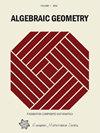On the Kirwan map for moduli of Higgs bundles
IF 1.7
1区 数学
Q1 MATHEMATICS
引用次数: 2
Abstract
Let $C$ be a smooth complex projective curve and $G$ a connected complex reductive group. We prove that if the center $Z(G)$ of $G$ is disconnected, then the Kirwan map $H^*\big(\operatorname{Bun}(G,C),\mathbb{Q}\big)\rightarrow H^*\big(\mathcal{M}_{\operatorname{Higgs}}^{\operatorname{ss}},\mathbb{Q}\big)$ from the cohomology of the moduli stack of $G$-bundles to the moduli stack of semistable $G$-Higgs bundles, fails to be surjective: more precisely, the "variant cohomology" (and variant intersection cohomology) of the stack $\mathcal{M}_{\operatorname{Higgs}}^{\operatorname{ss}}$ of semistable $G$-Higgs bundles, is always nontrivial. We also show that the image of the pullback map $H^*\big(M_{\operatorname{Higgs}}^{\operatorname{ss}},\mathbb{Q}\big)\rightarrow H^*\big(\mathcal{M}_{\operatorname{Higgs}}^{\operatorname{ss}},\mathbb{Q}\big)$, from the cohomology of the moduli space of semistable $G$-Higgs bundles to the stack of semistable $G$-Higgs bundles, cannot be contained in the image of the Kirwan map. The proof uses a Borel-Quillen--style localization result for equivariant cohomology of stacks to reduce to an explicit construction and calculation.关于Higgs丛模的Kirwan映射
设$C$为光滑复投影曲线,$G$为连通复约群。证明了如果$G$的中心$Z(G)$是不连通的,那么$G$-希格斯束的模堆到$G$-希格斯束的模堆的上同调的Kirwan映射$H^*\big(\operatorname{Bun}(G,C),\mathbb{Q}\big) $右行H^*\big(\mathcal{M}_{\operatorname{Higgs}}^{\operatorname{ss}},\mathbb{Q}\big)$不是满射:更准确地说,半稳定的$G$-Higgs束的$\mathcal{M}_{\operatorname{Higgs}}^{\operatorname{ss}}$的“变上同调”(和变交上同调)总是非平凡的。我们还证明了从半稳定的$G$-Higgs束的模空间到半稳定的$G$-Higgs束的堆的上同调的回拉映射$H^*\big(M_{\operatorname{ss}},\mathbb{Q}\big)$的像不能包含在Kirwan映射的像中。该证明使用了堆栈等变上同调的Borel-Quillen-风格的局部化结果,从而简化为显式的构造和计算。
本文章由计算机程序翻译,如有差异,请以英文原文为准。
求助全文
约1分钟内获得全文
求助全文
来源期刊

Algebraic Geometry
Mathematics-Geometry and Topology
CiteScore
2.40
自引率
0.00%
发文量
25
审稿时长
52 weeks
期刊介绍:
This journal is an open access journal owned by the Foundation Compositio Mathematica. The purpose of the journal is to publish first-class research papers in algebraic geometry and related fields. All contributions are required to meet high standards of quality and originality and are carefully screened by experts in the field.
 求助内容:
求助内容: 应助结果提醒方式:
应助结果提醒方式:


